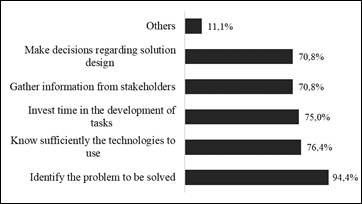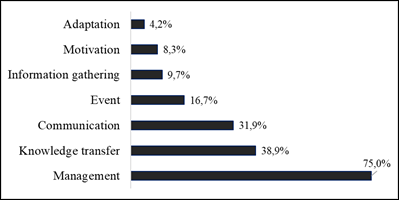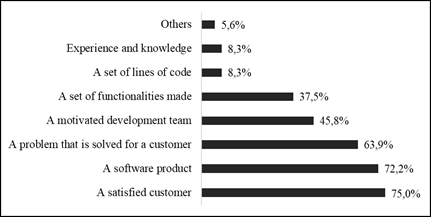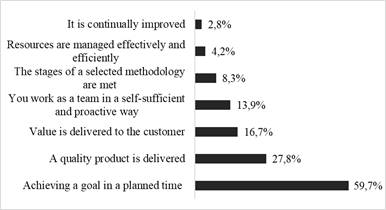I. INTRODUCTION
The origin of the concept of productivity dates back to the end of the 18th century as a purely economic measure. Within Software Engineering (SE), productivity began to be a topic of interest in the late 1970s [1]. From that moment, the study to define productivity in SE has been influenced by various aspects, those focused on measuring a project [2], the number of lines of code produced or functionalities developed [1,3], or the production rate of outputs generated on some unit of effort or input [4,5].
Now, if we talk about team productivity in ASD, the concepts seen above take another course, where the delivery of value, customer satisfaction, response to change and interaction between individuals take center stage [6]. When the productivity achieved in a team is greater than the sum of the productivity of the individual members, the team becomes effective [7,8]. Measuring productivity in ASD generates information that allows comparing the efficiency of developers within a team [4], and to improve it, it is necessary to evaluate behavior on a regular basis in order to obtain information that helps software project managers make decisions [9].
In ASD, the concept of productivity is quite unexplored [10] and its perception is completely different from the traditional view [11]. In [12,13] it is stated that productivity measurement becomes an element of greater complexity when an ASD team performs activities related to knowledge whose output is more of an intangible product and it is difficult to evaluate.
Regarding the background that supports this study, in [14] the team factors associated with interpersonal relationships are identified as positively correlated with productivity; leadership meetings and unit and regression tests generate a negative impact.
In the study carried out by [5], they establish the level of significance that measuring productivity through early and frequent value delivery can have for software industry professionals.
In [15] it is determined that the maturity of the team along with the identification of its characteristics can help improve productivity in ASD contexts. In [16] a model for improving team productivity in Extreme Programming (XP) is proposed, which is developed based on the most influential team characteristics such as motivation, collaboration and communication, customer participation, and personal culture.
Due to the aforementioned, the motivation of this research is to identify the conceptions found in the literature on productivity in ASD and compare them with the perceptions that software developers have on this factor in order to identify their similarities and possible differentiating aspects.
The article is organized as follows: Section 2 presents the methodological design of the research; Section 3 presents the results; finally, Section 4 details the conclusions.
II. METHODOLOGY
The present study was developed under three important phases. Figure 1 summarizes the methodological design of the research.
A. Identify Conceptions of Team Productivity in ASD as Presented in the Literature
For the compilation of conceptions in the literature, a systematic literature mapping was performed following the adaptation of protocol proposed by [17] and shown in Figure 2.
1) Research Question. The first motivating element of this study is to determine What are the conceptions of team productivity in ASD presented in the literature?
2) Search Criteria. The selected search string was run on SCOPUS, which is the largest source of citation data and abstracts of peer-reviewed literature [18].
Table 1 Search string.
| "Productivity" | AND | “team” | AND | "Agile Software Development" OR "Agile methods" |
3) Selection criteria: Inclusion and Exclusion. To select the studies, the criteria set out in Table 2 are considered.
Table 2 Inclusion and Exclusion Criteria
| Inclusion Criteria | Exclusion Criteria |
|---|---|
| 1. Studies published between 2001 and 2020. | 1. Studies published before 2001. |
| 2. Studies published in English. | 2. Studies whose area of knowledge is different from Computer Science. |
| 3. Studies whose area of knowledge is Computer Science. | 3. Studies not previously cited. |
| 4. Studies whose key words emphasize agile software development. | 4. Studies that do not involve productivity in agile software development. |
| 5. Studies cited by other authors. | 5. Technical reports and articles for debate or discussion. |
| 6. Studies related to productivity in agile software development. | 6. Studies not available in full text. |
| 7. Complete studies published in journals, conferences, or congresses. | 7. Duplicate studies. |
4) Abstract and Keyword Review. The classification scheme was based on the application of the inclusion and exclusion criteria, and the filters in Table 3 that allowed the selection of studies. Figure 3 shows the results obtained.
Table 3 Selection Strategy.
| Filter | Description | Criteria | |
|---|---|---|---|
| Inclusion | Exclusion | ||
| 1F | Review the articles applying the search string in the SCOPUS reference manager. Other search parameters were the articles' publication rank, language, knowledge area, and keywords. | 1,2,3 and 4 | 1 and 2 |
| 2F | Identify the number of citations in the article. | 5 | 3 |
| 3F | Read the title, keywords, and abstract of the article applying the inclusion and exclusion criteria. | 6 | 4 |
| 4F | Read the results and conclusions of the article applying the inclusion and exclusion criteria. | 6 and 7 | 4,5 and 6 |
| 5F | Remove duplicate studies. | 7 | |
| 6F | Read the full article applying the inclusion and exclusion criteria. | 6 and 7 | 4,5 and 6 |
B. Gathering Software Industry Professionals' Perceptions of Team Productivity in ASD
For collecting perceptions, the study was guided by the six stages defined in [19] and exposed in Figure 4.
1) Setting Objectives. The objective of the survey was to characterize the perceptions of team-level productivity held by Software Industry professionals from an ASD perspective.
2) Survey Design. This study is characterized by being cross-sectional [19] and the survey was addressed to professionals in the software industry in May 2021.
3) Developing a Survey Instrument. The instrument consisted of nine questions and four sections, which include: instructions for completion, basic participant information and acceptance of informed consent, sociodemographic information about Software Industry professionals and the perception of team productivity.
4) Survey Instrument Evaluation. For the validation of the questions, a panel of two experts was used and a pilot test was carried out with 10 professionals. Based on the recommendations, adjustments were made and the questionnaire was applied digitally using Google Forms (Link: https://forms.gle/eNMgg2SztJihTBg27).
5) Obtaining Valid Data. Sampling for the selection of the study population was intentionally non-probabilistic. The acceptance criteria were working in the software industry and expressing an explicit desire to participate on a voluntary basis.
III. RESULTS
A. Conceptions of Productivity in the Literature
Table 4 summarizes the conceptions of team productivity in ASD presented in the literature with their dimensions.
Table 4 Productivity Conceptions in ASD.
| ID | Definition | Dimension |
|---|---|---|
| C1 [11] | Teams do not share the same perception of productivity. Team composition, team assignment, and staff turnover all influence team productivity. |
|
| C2 [12] | A determining factor in improving productivity is agile team management. At the intra-team level, it is highlighted that the design of the team related to the structure and work assignment favorably influences productivity. At the intergroup level, coordination is evidenced as an element of vital importance. |
|
| C3 [20] | Productivity in ASD teams has to do with timeliness, quantity of work produced, efficiency, product quality, and customer satisfaction. |
|
| C4 [13] | Team productivity in ASD influences project performance and evolution. Among the factors that can influence productivity are motivation, team effectiveness, team management and customer satisfaction. |
|
| C5 [15] | Mature teams are highly productive because they combine characteristics such as communication, cohesion, trust, support, problem solving, and shared leadership. |
|
| C6 [14] | The most relevant factors are the ability to assign roles within the team, the interaction between teams, the handling of requirements such as user stories, the speed and team improvement, the quality of compliance and the team vision. Similarly, coordination is highlighted, and team empowerment can positively influence productivity. |
|
The term productivity in software development is related as the output production rate over input unit [4,5]. To increase productivity in a software project, it is necessary to increase the functionalities or reduce the effort invested to achieve the objective. Therefore, it is essential that this transformation be carried out by the work team [4].
Based on the conceptions identified in the literature, dimensions that relate the inputs, outputs, or the process that a team considers becoming productive can be established. Table 5 summarizes this information.
For this research, the concept of team productivity in ASD is defined as an indicator that evaluates the results obtained by a team after the construction of a quality functional software product that meets the expectations of a client and is delivered on time. For this, it requires team effort needed to fulfill a task, and the process it carries out managing its working methods and combining elements of interaction such as coordination, communication, cooperation, leadership, and problem solving for achievement of goals.
B. Software Industry Professionals' Perceptions of Team Productivity in ASD
The survey was applied to 72 professionals from the software industry who voluntarily participated in this process. The time invested for data collection was 30 days, where the interested parties were contacted and motivated.
1) Socio-Demographic Information. The results generated after applying the survey showed that 89% of the surveyed population is male (64) and the remaining 11% is female (8). Regarding the country of residence, professionals from Colombia 93.1% (67), Mexico 5.6% (4), and the United States 1.4% (1) participated.
According to the role played by professionals, it is found that most of the population (53), equivalent to 73.6%, are software developers.
2) Productivity Perceptions. Once the concept of team productivity in ASD has been consolidated from the perspective of [4,5] and from the dimensions described in Table 5, it was contrasted with the imaginaries of the 72 professionals in the software industry.
Regarding the inputs considered, it is evident that the identification of the problem to be solved (94.4%) is the most representative option by the respondents (Figure 5). In addition, software industry professionals consider that the knowledge and appropriation of technologies to be used for the development of their activities is essential when developing software (76.4%). However, although the previous option is not detailed in the literature, it does consider the transfer of knowledge as an input to start a software project and it is not necessarily associated with the use of tools. 11.1% of the respondents detailed those other inputs were the composition of the team and soft skills, which may well relate to motivation.
Professionals' perceptions focus on presenting activities that do not necessarily involve teamwork. For example, collecting information from stakeholders. The purpose of this research is to establish the distance that exists between perceptions and literature. In this sense, the theoretical references propose input actions focused on the team; however, the orientation of the professionals' perceptions is presented from a general productivity perspective.
Continuing with the activities that contribute to an ASD team becoming productive, it is evidenced that Management is the most recurrent option by professionals with 75% (See Figure 6), which agrees with the information obtained in the literature and is related to processes such as planning, organization (Work assignment), execution (Coordination), and evaluation. Another similarity is that they consider communication within the team as a fundamental pillar to increase productivity.
In relation to the elements that differ from the theoretical referents, the professionals' imaginaries also include again knowledge transfer and motivation, but in the literature, they are related to inputs. In addition, the literature presents additional characteristics that a work team should have to improve its productivity, such as: cohesion, trust, problem solving, shared leadership, and customer participation [15].
On the other hand, to refer to the outputs obtained by an ASD team, it is found that the respondents (Figure 7) include customer satisfaction (75%), the generation of a software product (72.2%), and a problem that is solved for a customer (63.9%), as the most recurrent options. In the same way, the literature corroborates these results, considering that, to satisfy a customer, it must be articulated with the principles and values of ASD, such as the frequent delivery of value that meets the expectations raised. However, professionals do not consider factors included in the literature such as: quality, efficiency, effectiveness, improvement, and team speed.
Finally, software industry professionals do not consider team qualities as outputs achieved (only Motivation, but it is defined as an input in the literature) including only software solution as the preferred position.
In the notion of productivity formulated by the respondents in Figure 8, a position away from the software development team is identified, where 13.9% of professionals establish differences between productivity and team productivity. Perceptions are fundamentally focused on achieving a goal in a planned time (59.7%).
C. Contrast Between Conceptions and Perceptions of Team Productivity
Once the contrast between the conceptions of team productivity in ASD and the imaginaries of software industry professionals has been made, similarities and differences are found.
The productivity of the team in ASD for software industry professionals considering the definition of [4], and the productivity dimensions exposed in this document is linked with the satisfaction of a customer through the delivery of a software product (output), managing each one of the activities that are proposed (process) and early identifying a problem to solve (input) to achieve a goal successfully.
The above has allowed us to synthesize that, despite the fact that some of the informants already incorporate the agile culture in their organizations, and considering that team productivity is an abstract concept, professionals focus on equating it through a general and conventional perception of productivity. On the other hand, for professionals in the software industry, it is still not possible to detail the integration of the work team with the software process and the activities that may arise, which, within the ASD framework can favor relationships among members, and therefore the improvement of productivity.
IV. CONCLUSIONS
The concept of team productivity in ASD presented in the literature is categorized in three dimensions: input, process, and output. Likewise, it is evidenced that some productivity dimensions identified refer to the software development team, as well as to the effort invested to achieve an objective that adds value to a customer.
According to the perception that the 72 software industry professionals surveyed have on productivity, it is identified that there is a general, conventional notion that does not take teamwork into account. The professionals' answers focus on the fulfillment of an objective or on the delivery of a software product, leaving aside activities that contribute to improving the relationships and interaction among team members.
When contrasting the notions exposed in the literature by different authors with the opinions of software industry professionals, the similarities found are that: the definition of team productivity is oriented towards satisfying a customer by delivering a functional software product, managing activities of the development process, identifying the problem to be addressed, including the transfer of knowledge in the team, and investing time in the fulfillment of the objective. The main difference is that the literature specifies the concept of team productivity while professionals refer to it from the general concept of productivity.
The main limitation of this study is due to the size and type of population, considering that the largest percentage of participation (93.1%) belongs to the software industry in Colombia. Likewise, 73.6% of the professionals reported having the role of developer. Likewise, among the respondents there was no difference between those who worked independently and those who worked as part of an ASD team in an organization. It would be interesting to replicate this research in a population of professionals from different countries, where the participants are working in an ASD team at the business level and are discriminated by the role that each member plays.























